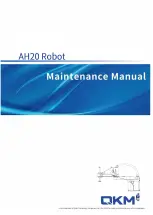
106 / 125
Issued: 16.03.2016 Version: MA KR 300 470-2 PA V5
KR 300-2 PA, KR 470-2 PA
8.2 Limitation and monitoring of exposure
Derived No Effect Level:
No DNELs/DMELs available.
Predicted No Effect Concen-
tration:
No PNECs available.
Appropriate engineering
controls:
Provide exhaust ventilation or other engineering controls to
keep the relevant airborne concentrations below their respec-
tive occupational exposure limits.
All activities involving chemicals should be assessed for their
risks to health, to ensure exposures are adequately controlled.
Personal protective equipment should only be considered after
other forms of control measures (e.g. engineering controls)
have been suitably evaluated. Personal protective equipment
should conform to the applicable standards and be suitable for
the intended purpose, be kept in good condition and be main-
tained in accordance with the regulations. Select personal pro-
tective equipment in compliance with the valid standards. For
this purpose, please consult your supplier of personal protective
equipment. Further information about standards is available
from your national organization responsible.
The final choice of protective equipment will depend on a risk
assessment. It must always be ensured that all items of per-
sonal protective equipment are compatible with one another.
Personal safety precautions
Hygiene measures:
Wash hands, forearms and face thoroughly after handling
chemical products and before eating, smoking or using the toi-
let, as well as at the end of the working day. Ensure that eye-
wash stations and safety showers are close to the workstation
location.
Respiratory protection:
Respiratory protection is not normally required where there is
adequate natural or local exhaust ventilation to control expo-
sure.
Where there is insufficient ventilation, wear suitable respiratory
equipment.
The correct choice of respiratory protection depends upon the
chemicals being handled, the conditions of work and use, and
the condition of the respiratory equipment. Safety procedures
should be developed for each intended application. Respiratory
protection equipment should always be chosen in consultation
with the manufacturer and in accordance with the local working
conditions.
Eye/face protection:
Protective goggles with side shields.
Summary of Contents for KR 300-2 PA
Page 6: ...6 125 Issued 16 03 2016 Version MA KR 300 470 2 PA V5 KR 300 2 PA KR 470 2 PA...
Page 8: ...8 125 Issued 16 03 2016 Version MA KR 300 470 2 PA V5 KR 300 2 PA KR 470 2 PA...
Page 12: ...12 125 Issued 16 03 2016 Version MA KR 300 470 2 PA V5 KR 300 2 PA KR 470 2 PA...
Page 38: ...38 125 Issued 16 03 2016 Version MA KR 300 470 2 PA V5 KR 300 2 PA KR 470 2 PA...
Page 60: ...60 125 Issued 16 03 2016 Version MA KR 300 470 2 PA V5 KR 300 2 PA KR 470 2 PA...
Page 64: ...64 125 Issued 16 03 2016 Version MA KR 300 470 2 PA V5 KR 300 2 PA KR 470 2 PA...
Page 76: ...76 125 Issued 16 03 2016 Version MA KR 300 470 2 PA V5 KR 300 2 PA KR 470 2 PA...
Page 122: ...122 125 Issued 16 03 2016 Version MA KR 300 470 2 PA V5 KR 300 2 PA KR 470 2 PA...
Page 125: ...125 125 Issued 16 03 2016 Version MA KR 300 470 2 PA V5 KR 300 2 PA KR 470 2 PA...











































